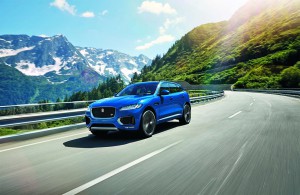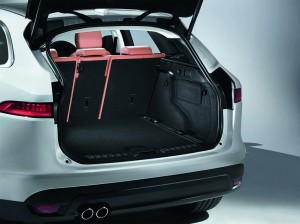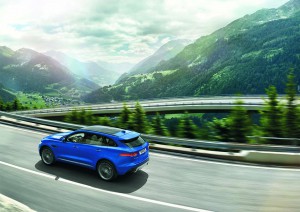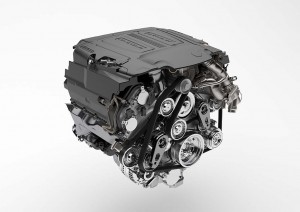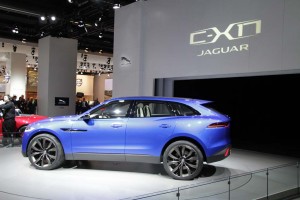Jaguar is set to take perhaps the biggest risk in its 93-year history, but one that could yield the sort of payoff the long-struggling British brand desperately needs.
At the Frankfurt Motor Show this week, Jaguar will formally unveil its first-ever utility vehicle, the F-Pace. The crossover, which shares its underlying platform with more traditional models like the newly redesigned Jaguar XF, risks alienating traditional buyers. But it could also attract the sort of luxury buyers who have long steered clear of the British marque.
“We designed the all-new F-Pace to be first and foremost a Jaguar,” insists Ian Callum, the brand’s chief designer. But company officials acknowledge that the new utility vehicle could come as a shock to those who traditionally associate the name, Jaguar, with sleek and sensuous sports cars, like the legendary E-Type, as well as sporty coupes and sedans.
(The new F-Pace is just part of a “fundamental transformation for Jaguar. Click Here for more.)
Jaguar first teased its move into the crossover market with the 2013 C-X17 concept. It now has released images and details of the F-Pace ahead of its official Frankfurt unveiling, and there’s no question that the crossover-utility vehicle picks up the distinctive cues of more classic Jaguars, such as the 2016 XF, as well as the F-Type sports car.
That includes the mesh grille, the sweeping headlamps, with their J-shaped LED running lights, the more coupe-like curve to the roofline, and taillights clearly influenced by the F-Type.
“Every Jaguar car should draw your eye from 200 meters away,” said Callum, who describes the F-Pace as having “latent poise – a svelte car with attitude.”
One reason Jaguar was able to pick up the basic proportions and styling cues of its classic models is that fact the F-Pace shares the same new Lightweight Aluminum Architecture, as the 2016 Jaguar XF and the upcoming XE compact luxury sedan. The lightweight platform also means that the F-Pace has a bit less mass than competing, steel utility vehicles, Jaguar officials emphasize. They promise that will translate into a more nimble ride, improved performance and better handling.
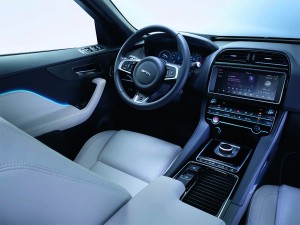
The new F-Pace offers a suite of high-tech features, including the latest Jaguar infotainment system.
The midsize utility vehicle has a moderately long wheelbase of 113 inches, which provides a fairly roomy interior for its segment. The F-Pace is also one of the wider CUVs in its class, giving ample room for three passengers in the second row.
The new platform uses a double-wishbone front suspension and an Integral Link rear, pretty much state of the art among today’s utility vehicles, which have moved away from classic SUV design to put more emphasis on road manners than off-road capabilities. To further improve highway behavior, the electric power-assist steering is speed sensitive and a variable pitch gear set that is intended to make it more responsive the more the driver turns the wheel, Jaguar explains.
Initially, the Jaguar F-Pace will be offered with two different versions of the maker’s 3.0-liter supercharged V-8, one turning out 340-horsepower, the other 380, through an 8-speed automatic transmission. In the U.S., only an on-demand all-wheel-drive system will be offered, reflecting recent trends in the luxury market.
While Jaguar hasn’t released fuel economy numbers it expects to do well in its competitive set, in part due to the lightweight aluminum-intensive platform. It does indicate the 380-hp V-6 should be able to get the F-Pace from 0 to 60 in about 5.1 seconds, with an electronically limited top speed of 155 mph.
But other powertrain options should follow. Jaguar has confirmed it will add a 180-hp Ingenium diesel later in 2016. It will make 317 pound-feet of torque. A front-drive version could follow. And with Jaguar working up several different electrified packages, a hybrid or plug-in could be in store, eventually.
(Jaguar Land Rover reveals three Concept_e battery car prototypes. Click Here to check them out.)
To further enhance the AWD system, Jaguar says the F-Pace will offer its new Adaptive Surface Response system, or AdSR. The technology “automatically adapts the maps of the throttle, transmission and DSC system according to the type of surface to maximize traction in a variety of conditions,” the maker explained in a background document.
Unlike some crossovers which really can’t handle much more than snow or gravel, Jaguar claims the F-Pace will have some reasonable off-road capabilities, enhanced by 8.4-inches of ground clearance.
Technology is as important as performance to many buyers in the segment, and F-Pace will offer such features as a laser-based Head-Up Display, active cruise control capable of bringing the crossover to a complete stop in traffic, blind-spot warning and cross-traffic alert.
The F-Pace also will introduce a new version of the Jaguar InControl Touch infotainment system with a new 8-inch touchscreen. The optional TouchPro version upgrades that to a 10.2-inch display.
In years past, Jaguar avoided getting into the utility vehicle segment, counting on buyers to turn to its sibling brand, Land Rover. That apparently worked for the other British marque which has posted huge growth in recent years and has reached record levels of sales. Jaguar, on the other hand, has barely been keeping up with the pace of the recovering automotive market, especially in the U.S.
At a time when utility vehicles are outselling sedans for the first time, the lack of a product like F-Pace was a serious weakness, contended Joe Eberhardt, CEO of Jaguar’s North American operations. At the moment, the brand is being considered by only 6% to 7% of potential luxury buyers, he said, adding, “We have to double that.”
F-Pace alone won’t get Jaguar there. It needs additional product, such as the compact XE. Between them, that downsized sedan and the new F-Pace crossover are targeting two of the fastest-growing segments in the global auto industry. So, even if traditionalists balk, Jaguar is convinced the new utility vehicle will be critical to its long-term success.
(Click Here for a review of the new Range Rover Sport Td6.)

